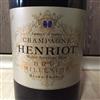1996 Horizontal, with Chef de Cave from Henriot, Moet and Roederer
London
Tasted Tuesday, December 13, 2005 by Russell Faulkner with 1,965 views
Introduction
A hard mornings work at the Institute of Masters of Wine with three tutored tastings, followed by a walk around tasting of 20 1996 Champagnes.
1996 is almost universally recognised as a superb Champagne vintage, however what surprised me was the comments from the three Chef de Cave regarding caution on (very) long term aging potential for these wines, pointing out that many of the great ‘aging’ vintages (1928, 1945, 1976) were low acid vintages. Clearly these wines need time to integrate the acidity, but the consensus was that these will not be wines for drinking in the latter half of this century.
Flight 1 - Champagne Henriot – tutored by Chef de Cave Odilon de Varine (4 Notes)
Henriot is not a house I am familiar with, still family owned, with a production of around two million bottles a year. The house does not have tranched disgorgements, with all vintage wines disgorged within 1-2 months. Odilon went to lengths explaining how Henriot like vintages to be different, using different vineyard selection in different vintages, for example, much of the Chardonnay for vintage wines comes from Chouilly, but they have three different vineyards, two of which are tight and lean, and one lower on the slope, with more soil coverage that tends towards a rounder, more full expression. They select depending on the vintage character. 100% malolactic.
Flight 2 - Champagne Moet & Chandon – tutored by Chef de Cave Benoit Gouez (3 Notes)
An interesting observation on the three different winemakers, they were very representative of the hose
3-5% of production is vintage, so less Moet than Dom Perignon is produced. Again winemaking very much adapted to vintage, other than that malo is always carried out. At Moet they do not like the taste of ‘malic’, it was also mentioned that additional sulphur would be needed if these did not go through malo, which given the levels seen is terrifying! Also very low levels of reserve wines are kept, nothing beyond 1999! I am sure this contributes to the general lack of quality in Moet NV
Flight 3 - Champagne Louis Roederer – tutored by Chef de Cave Jean Baptiste Lecaillon (4 Notes)
Jean Baptiste is a fascinating guy. He explained that at Roederer they try to make a vintage wine every year, and will work very hard in the vineyard to achieve it. However there is a clear quality based approach apparent, Roederer are very much aligned to the attitudes of the best growers. Two thirds of vineyards are owned, and are all in Grand Cru villages. The approach to malolactic is varied each year depending on the vintage. Methods are non intrusive and non oxidative (malo is stopped by very cold cellars, not sulphur). Vineyards are separately vinified. The best blocks go through fermentation in 6000 litre oak casks, with weekly battonage. What surprised me was that the three very best (better than Cristal) barrels of wine are reserved each year to use for the ‘dosage liqueur’.
1996 had the highest malolactic levels ever seen by roederer, and a real water deficit, they picked over a much longer period than most, following as the malic in the grapes dropped away, as a result grapes were riper than almost all other houses.
Dosage
The producers then engaged in an interesting debate on dosage. All agreed that using the same wine for the ‘dosage liqueur’ was rarely successful, Roederer having done extensive research on this. Henriot stated the single most important element of dosage is not the amount of sugar to add (this is second) or when to do it (third) but what wine to use. Henriot use around 8 g/l and are pretty consistent each year. Moet are higher at around 11 g/l but it can be from 9-12 g/l. Roederer (unsurprisingly) vary the most, but remain usually around 10-12g/l.
Flight 4 - 1996 Tasting (15 Notes)
Closing
Overall, even though there weren’t all of the ‘top’ wines on show, clearly 1996 is a very good vintage, but many of the houses put out far too many bland, boring, middle ground wines. The Bollinger, Jacquesson and Taittinger Comtes were the best wines, The Joseph Perrier was a nice surprise, this house has only disappointed in the past.


1990 Henriot Champagne Brut Millésimé
France, Champagne
49% CH 51% PN. From Jero
Reductive nose, clear sulphur, full bodied attack but that level of reductive sulphur is not going to die away.
Post a Comment / Do you find this review helpful? Yes - No / Report Issue
1995 Henriot Champagne Brut Millésimé
France, Champagne
47% CH 53% PN, Disgorged May 2000. From Magnum
Much more approachable, round full ripe body, my favourite of the Henriot wines
Post a Comment / Do you find this review helpful? Yes - No / Report Issue
1996 Henriot Champagne Brut Millésimé
France, Champagne
48%CH 52%PN Disgorged 2004
Quite light on attack, but clear floral honeysuckle notes, a steely acidic finish
Post a Comment / Do you find this review helpful? Yes - No / Report Issue
1996 Henriot Champagne Brut Millésimé Rosé
France, Champagne
45%CH 55%PN (10% of which is still wine) Disgorged 2002 (early to keep fresh)
Light copper pink, slight nose, quite light body, slight citrus and floral notes, slightly metallic finish, likely from sulphur but will integrate
Post a Comment / Do you find this review helpful? Yes - No / Report Issue